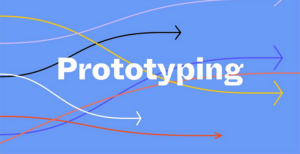UX research, UI design, and web design have been the most discussed topics of design lately.
It’s 2022, the age of virtual reality, augmented reality, automated cars, and voice technology. All of which sounds like something from a sci-fi movie. On a serious note, voice tech has its prominent space in today’s world. So many brands want to catch up with this trend. Let’s talk about voice UX and how it is proving to be a useful technology of the future.
Through this article, you’ll get an overview of voice UX prototyping. Contrary to how fancy it sounds, it is not a complicated process, just different from the usual UI prototyping method for website/app designs.
Voice UX is the new mode of digital conversation
Voice interactions aren’t as logical or linear as user flows within a website or an app. A conversation can happen anywhere, anytime. On the other hand, on a website or app, a user can only go where you allow them to.
We should also consider the fact that the user is not going to communicate in the same way as they write. A voice conversation is a natural flow that can circle back to the previous task/point but can go backwards or forward as well.
It’s a different interaction altogether, like when you’re searching for hazelnut coffee on your phone vs asking a voice assistant to order one for you. It’s also different when you misspell “Hazelnut” in a browser search bar vs when a voice assistant didn’t understand what you said. You have to start by being open-minded that is how any conversation started and goes on.
We can’t proceed without a voice persona
Start by considering the role your voice app will play within the user experience. Next, you must figure out who is your persona and how does the persona of your voice app represent the brand?
A voice application of any kind is an extension of your brand. You should first figure out what the company brand is and then reflect those characteristics to define the persona of the voice app. Just imagine the user is going to interact with your brand extension by its voice, it’s new and definitely exciting, also delightful at the same time. It can be a good opportunity to create a strong bond between the brand and its users.
Defining the characteristic of your persona will have a radical effect on how users will perceive your voice app and your company. For eg, is your voice female or male? Is it funny, witty, or professional? These things matter. One thing worth underlining here is that whatever you do, at the end of the day it should be relatable for your users.
Defining commands
Next, you will require identifying and defining where a possible voice interaction could, would, or should happen within a user flow. Although, it is not quite possible to be able to write it all out within a user flow the same way you can’t design the mobile app pages within it either.
After indicating where they happen, briefly describe the scenarios in which a voice interaction would happen. This will give you a clear purpose of voice interaction and a lot more context for writing out a sample dialogue. And that’s what you do next. For each scenario, write out your sample dialogues.
Consider this scenario as an example.
User: I want to order a hazelnut coffee.
Voice app: Hey Sam, no problem. I see you’ve ordered hazelnut coffee the last few times. Do you want to order a Colombian Brew Coffee — Nutty Hazelnut of 50 grams packet again?
User: Yeah, sure.
Voice app: Great! Do you want us to deliver it to your home or want to change the address?
User: Deliver it to my house.
Voice app: The house address we have with us is B-302 Alphabet Street, New Jersey, is that correct?
User: Yes it is.
Voice app: You got it. That’s going to be $15.79. Do you want to pay with one of your pre-saved cards or should we make it a cash-on-delivery?
User: I’d like to pay with cash
Voice app: Congratulations. Your order has been placed and we’ve emailed you an order confirmation. Your order shall arrive on Friday, 7th Aug.
Now it’s time for voice prototyping
Finally, we’re into the prototyping stage! There are many tools out there for this but only a couple of tools are useful when it comes to voice prototype setup.
You can try out one of the following apps;
- The storyline: It is an interface mapping tool for Alexa Skills.
- Sayspring: A voice interface tool for both Alexa and Google Assistant.
- Botsociety — It is a multi-platform voice prototyping tool for Messenger, Slack, Alexa, and Google Home.
- Dialogflow — A tool for building natural conversation experiences.
A few things are essential to this process and help in creating user-centric and efficient voice UX prototypes and services.
Documenting the conversations
As per my experience in all kinds of UX processes, documenting is an essential process. So you should always keep your prototype and dialogues well documented. Each dialogue should have a unique name, and type (an order, payment, cancellation, etc.). Initiation (what prompts this specific dialogue), and the outcome (what will this achieve for the user? What can the user expect next?).
Preparing got error states
Errors are bound to occur for a variety of reasons, from the voice app not recognizing what the user said, the user not providing the appropriate information required to move on, speaking with a heavy accent, noisy areas, taking too many pauses, and so on.
You should include all the possible scenarios of error states. The best way to address errors when the user is not compliant is to provide progressive and helpful directions. You want to mitigate the problem or roadblock faced and make the user provide the proper information instead. If you are asking a user “Do you want to pay through one of the pre-saved cards or choose cash on delivery?”, a user can tell you this information in several ways such as a long pause “Hmmm” or “ I guess I would prefer COD”, or by just a simple “Yes”.
So you need to consider all kinds of scenarios.
Here is an example:
Voice app: You got it. That’s going to be $15.79. That’s going to be $15.79. Do you want to pay with one of your pre-saved cards or should we make it a cash-on-delivery?
User: Hmmm.
Voice app: (After a couple of seconds). I am waiting.
User: I guess I want to prefer the COD
Voice app: Did you mean Cash on delivery?
User: Yes
Voice app: Congratulations. Your order has been placed and we’ve emailed you an order confirmation. Your order shall arrive on Friday, 7th Aug.
Make sure to make room for all possibilities.
Let’s test your prototype
This is the point where your all efforts, and ideas going to be out for a particular time. So go ahead and test the prototype with real people and figure out how well your voice app is doing.
“There’s a joy in having the molecule of an idea, then testing it in front of audiences at secret shows that people only know about the night before.” — Mike Myers
Conclusion
We have tried to cover the basic process of prototyping voice interactions. There can be a subpart/process of it. It depends on the project and requirements. Voice UX is a highly potent area full of opportunities that can enhance the user experience to a great degree and make doing certain activities even more convenient with the technology that awaits us.







